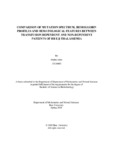Comparison of mutation spectrum, hemoglobin profiles and hematological features between transfusion dependent and non-dependent patients of Hb E/β Thalassemia
Abstract
Hemoglobin E/β Thalassemia is an inherited anemic genetic disorder that is highly prevalent in the Southern Asia part of the world. Bangladesh falls in the Thalassemia belt of the world. The clinical manifestation of this disease is widely heterogeneous. The patients are divided into three groups: severe, moderately severe and non-transfusion dependent. In Bangladesh, data about NTDT (Non-Transfusion Dependent Thalassemia) patients are scarce. However, studying NTDT patients is essential as the factors behind its widely variable clinical diversity are still unknown. Here, the mutation spectrum, hemoglobin profiles, and hematological features are compared between the transfusion-dependent and NTD patients to find a responsible factor behind the disease severity. Among the compared parameters, it had been found that Hb F and Hb E play a role in ameliorating the disease severity because the increase in gamma genes of Hb F decreases the α/β-chain imbalance and the high oxygen dissociation power of HbE. This study can be useful for the correct diagnosis of NTDT patients.

